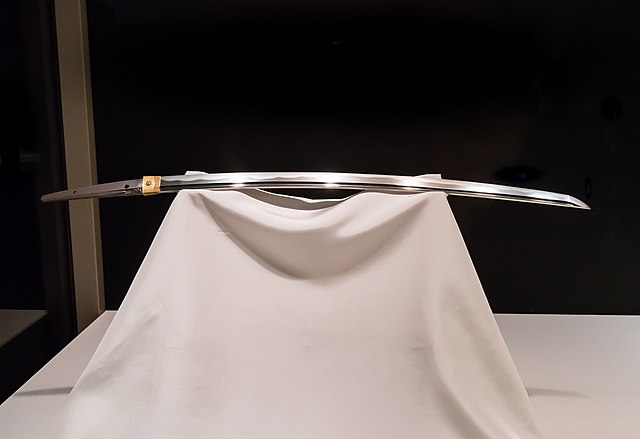Gorō Nyūdō Masamune was a medieval Japanese blacksmith widely acclaimed as Japan's greatest swordsmith. He created swords and daggers, known in Japanese as tachi and tantō, in the Sōshū school. However, many of his forged tachi were made into katana by cutting the tang (nakago) in later times ("suriage"). For this reason, his only existing works are katana, tantō, and wakizashi. No exact dates are known for Masamune's life. It is generally agreed that he made most of his swords between 1288 and 1328. Some stories list his family name as Okazaki, but some experts believe this is a fabrication to enhance the standing of the Tokugawa family.
The katana nicknamed Kanze Masamune in the Tokyo National Museum. National Treasure.
The katana nicknamed Tsugaru Masamune in the Tokyo National Museum. National Treasure.
The katana nicknamed Ishida Masamune in the Tokyo National Museum was formerly owned by Ishida Mitsunari. Important Cultural Property
Musashi Masamune, Important Art Object, Japanese Sword Museum.
A tachi is a type of sabre-like traditionally made Japanese sword (nihonto) worn by the samurai class of feudal Japan. Tachi and uchigatana generally differ in length, degree of curvature, and how they were worn when sheathed, the latter depending on the location of the mei (銘), or signature, on the tang. The tachi style of swords preceded the development of the katana, which was not mentioned by name until near the end of the twelfth century. Tachi were the mainstream Japanese swords of the Kotō period between 900 and 1596. Even after the Muromachi period (1336–1573), when katana became the mainstream, tachi were often worn by high-ranking samurai.
Itomaki-no-tachi style sword mounting with chrysanthemum and paulownia crests on nashiji laquer ground. The blade was made by Masatsune. Blade, 12th century; mounting, 18th century. Tokyo National Museum.
In the noh drama Sanjō Kokaji, the 10th-century blacksmith Munechika, aided by a kitsune (fox spirit), forges the tachi (samurai sword) Ko-Gitsune Maru.
Tachi, Okanehira, by Kanehira. Ko-Bizen (old Bizen) school. 12th century, Heian period, National Treasure, Tokyo National Museum. Okanehira, together with Dojikiri, is considered one of the best Japanese swords in terms of art and is compared to the yokozuna (the highest rank of a sumo wrestler) of Japanese swords.
Kazari tachi. 12th century, Heian period. National Treasure. Tokyo National Museum.








